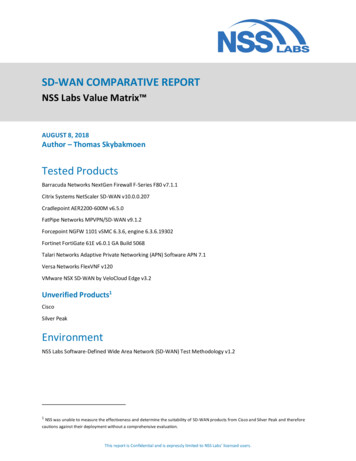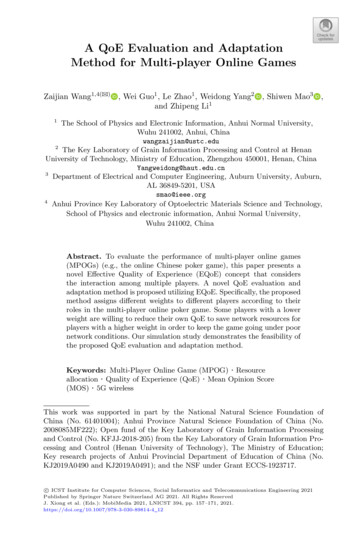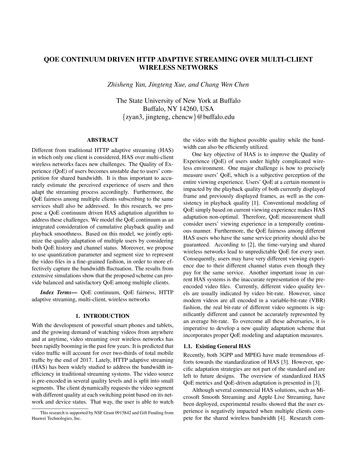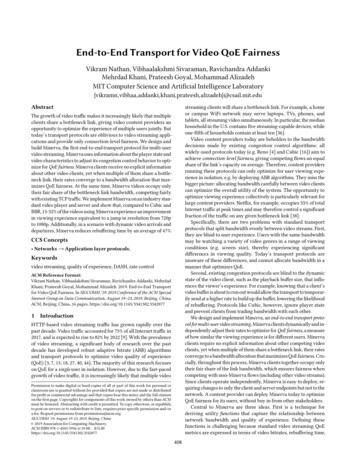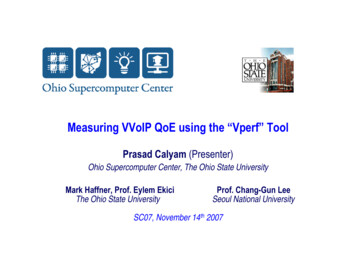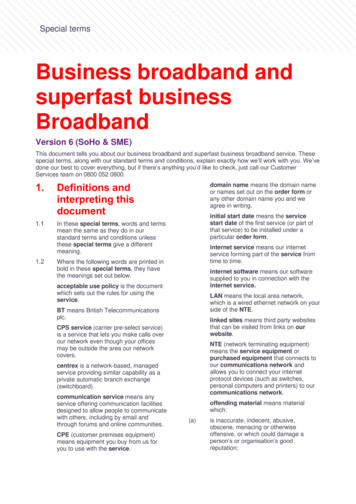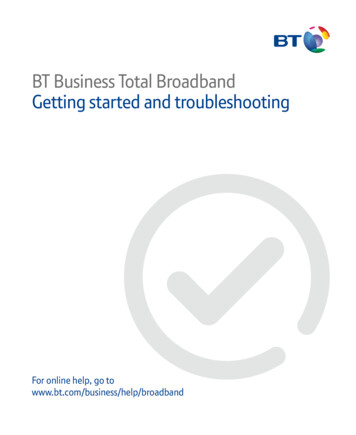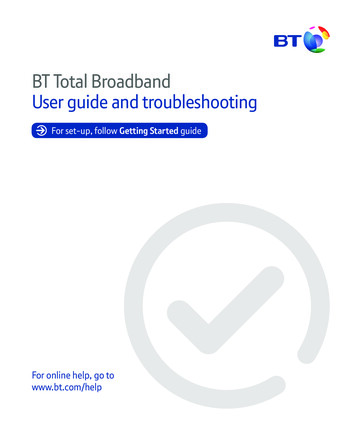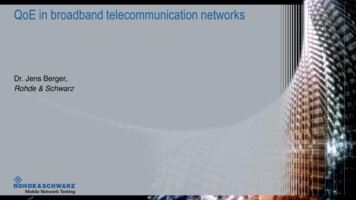
Transcription
QoE in broadband telecommunication networksDr. Jens Berger,Rohde & Schwarz
Agendaı Towards an integrative, overall QoE scoringı A bit of historyı Are technical KPIs representative for QoE?ı What drives ‘perception’ and ‘quality’?ı How to come to an integrative performance evaluation?QoE in broadband telecommunication networks2
Real-field QoE evaluationı Best QoE in daily life for a customer guarantees satisfaction and minimizes churn rate.ı The basic questions are:How good is my network or my service?Where I can improve my network or service at most efficient?ı For improving QoE we have to measure it first.ı Real-field performance evaluation is large scale analysis. How to handle myriads of measurement results? Smart aggregation without loosing drill-down capabilitiesQoE in broadband telecommunication networks3
Ho to come to ‘general’ and valid QoE scores?1.Transformation of technical measurements to KPIs based on perception2.Combination of (perceptive) KPIs to a QoE for a service3.Combination of ‘per service KPIs’ to general, overall QoE for a network, an operator, an region, There are links to:ITU E.840 (NetPerfRank)ETSI TR 103 559 (draft): Best practices for robust network QoS benchmark testing and rankingQoE in broadband telecommunication networks4
A bit of history – where we are coming from?ı For decades telecommunication networks are focused on voice telephony,data communication started with modems and text based servicesı In mobile networks, GPRS, EDGE and UMTS were the first data technologies Voice and Data are handled separately Data bitrates are low and always the bottleneck in the transmission chain Improving data throughput on the last mile (or the mobile channel) had immediate positive effect on QoEQoE in broadband telecommunication networks5
A bit of history – and where we are today?ı Data transport capacity has improved by sizes in the last years.ı Voice services are using the same transport scheme and are ‘just a little part of data’ı Even for mobile data communication 500 Mbit/s are possible (today!)ı Does it solve all problems of QoE? Networks are very heterogeneous, QoE is influenced by actual routing and resources The peak capacity is not ‘standard everywhere’, in reality there is a very wide variability in what you getdepending on load, position, day-time, subscription, The data link is often not the limiting factor anymore, content providing infrastructure, interconnectivityand end-user devices can become the bottleneck Services get smart, they adjust the data volume to varying channel capacitiesQoE in broadband telecommunication networks6
QoE of OTT services – 3rd party influencesGeneral problem for non-native servicesNetwork3rd areThe entire chaindetermines the QoECan be optimized by the operatorı There is no simple file-server approached by a downloader rather an active server and an intelligent client OTT services are adaptive to channel conditions and communicating with multiple sources at the same time The mobile network ‘just’ transmits and is blind to the content and communication However, the operator is blamed always for all issues QoE in broadband telecommunication networks
What is key for a network’s QoE performance?Just the average of technical KPIs?ı There are many ‘KPIs’ with questionable meaning (avg.) throughput / avg. max. throughput (avg.) video resolution (avg.) latency Heavy asymmetric distribution(log-normal, Cauchy, Pareto, )Vast majority of individualthroughputs below average.QoE in broadband telecommunication networks
What is key for a network’s QoE performance?Averaging in case of heavy-tailed distributionsı There are many ‘KPIs’ with questionable meaning (avg.) throughput / avg. max. throughput (avg.) video resolution (avg.) latencyBetter peak throughputs elsewhereincrease the average but do NOTsolve problematic areas. Heavy asymmetric distribution(log-normal, Cauchy, Pareto, )This is the problematicarea for users!QoE in broadband telecommunication networks
What is key for a network’s QoE performance?Averaging in case of heavy-tailed distributionsı Consideration of 10% and 90% percentiles 10% means 10% of all measurements arebelow this value. The higher, the better is the‘minimum performance’ of the network (lessvery weak areas). This is the problematic area, therefore theweight is the highest 90% means 90% of all measurements arebelow, means too: 10% are higher. This valuedescribes the ‘peak performances’ This value rewards the peak performance10% percentile90% percentile(describes low tail) (describes upper tail)
What is key for a network’s QoE performance?Averaging in case of heavy-tailed distributionsReal field data - Germany 2017ı There are many ‘KPIs’ with questionable meaning HTTP download throughput (avg.) throughput / avg. max. throughputMobile network (avg.) video resolution (avg.) latency Heavy asymmetric distribution(log-normal, Cauchy, Pareto, )QoE in broadband telecommunication networks
What drives perception? The often reported ‘data throughput’?Data Throughput is not what you perceive! but time. Data ThroughputDuration of a taskSaturationThis dominates the ‚Throughput KPI‘ averageperception-wise there is no differenceQoE in broadband telecommunication networks
What drives perception? a video example.ı Video on YouTube Video resolutionQoE in broadband telecommunication networks
What drives perception?Perception includes saturationtarget areano benefitMOS-like KPIs are considering saturationQoE in broadband telecommunication networks
What drives QoE of a service?Satisfaction is always fulfilled expectation, nothing else. This consists of more than one dimensionı People rating in ‘service categories’ I am convinced by calling via WhatsApp. I am not happy with Browsing on my mobile phone. I have issues with my TV service.Users have an integrative opinion across different dimensions.Classical measurement approaches do not have this!QoE in broadband telecommunication networks
What drives QoE of a service? What are dimensions of it?ı Service availability Do I have access to the service at all? Do I stop waiting because of too long waiting times?ı Waiting for ‘action’ (task being started and/or completed) How is the accepted duration (patience) for a normal ‘web task’,getting a call connected or seeing the video starting.ı How is the quality of the media (e.g. video, voice, pictures, ) Is the quality how I expect it? ( could be different from MOS)QoE in broadband telecommunication networksQoEof a service
What drives QoE of a service? What are dimensions of it?Example: Legacy Voice Telephonyı Service availability Example: OTT Telephony (WhatsApp, Line)Do I have access to the service at all?Call (Setup) Success RatioCall (Setup) Success Ratio Do I stop waiting because of too long waiting times?HSPA/LTE in EU: 90 95%CSR in CS/VoLTE in EU: 98%ı Waiting for ‘action’ (task being started and/or completed) CallHowSetupis the accepted‘web Setuptask’, TimeTime duration (patience) for a normalCallgetting a callCS/VoLTEinconnectedEU: 5s or seeing the video starting. HSPA/LTE in EU: 5sı Howis theQualityquality of(MOS)the media (e.g. video, voice,pictures, )SpeechQuality (MOS)Speech CSIs thequality howI expectit? (could be different fromHSPA/LTEMOS)in EU : 4.3 (Opus)in EU: 4.1(AMR-WB)VoLTE in EU: 4.5 (EVS 24.4)Latency: 200msLatency: up to 800msQoEof a service
What drives QoE of a service? What are dimensions of it?Example: YouTube videoı Service availability Do I have access to the service at all?Video Acces Success RatioDo I stop waiting because of too long waiting times?Germany/Austria/Switzerland: 96%ı Waiting for ‘action’ (task being started and/or completed) TimeHow istotheacceptedduration (patience) for a normal ‘web task’,startvideogetting a call connected or seeing the 3svideo starting.Germany/Austria/Switzerland:?ı Howis thequality(MOS)of the media (e.g. video, voice, pictures, )VideoQuality Germany/Austria/Switzerland:MOS from MOS)Is the quality how I expect it? (could 3.7be different almost everywhere 480p and aboveQoEof a service
How to combine and how to make most gain in QoE?ı How to rate KPIs different dimensions to each other? Simple example for ation0.5 Call Success Rate: 99.5%49/5098 / 1000.3 Call Setup Time:14s6 / 1002/300.2 Speech Quality:4.2 MOS90 / 100QoE in broadband telecommunication networks18/201969 / 100
How to get an ‘overall network QoE score’?Considering typical service types0.4Voice TelephonyVideoStreamingBrowsingSocial MediaData ServicesHTTP DataTransfer0.6QoE in broadband telecommunication networks20
How to get an ‘overall network QoE score’?Weighting and aggregation (e.g. by population categories)CityTownRoadRuralQoE in broadband telecommunication networks21
How to get an ‘overall network QoE score’?Works in both directionsCityTownOverall aggregation and rankingRoadRuralQoE in broadband telecommunication networks22
How to get an ‘overall network QoE score’?Works in both directionsCityTownRoadMainpotential toimproveRuralEfficient drill-down andtrouble shootingQoE in broadband telecommunication networks23
Providing best QoE for daily services is key for an operator!How to measure and how to optimize?1. Consideration of the whole transmission chain incl. CDN and user device2. Selection of KPIs representing perception or transformation into a perception domain, e.g.Video MOS instead of resolutionCompletion time for a task instead of data bitrate3. Combination of individual KPIs to ‘per service QoE’, e.g.Combination of availability, setup-time and speech quality for a telephony service to one value4. Combination of typical ‘per service QoE’ scores to an ‘overall QoE performance’ score fore.g. one provider, weighted by importance of the services and geographical population distributionRanking of networks, performance monitoringQoE in broadband telecommunication networks24
Measuring overall QoE performanceNext stepsı Gaining experience with the integrative scoring methodologiesı Statistical analysis, as:ı How much measurements are needed to get representative results for a region, a country, ?ı How is the remaining uncertainty?ı What is about convergence of individual contributors? How often I have to measure what?ı How to increase measurement density and convergence of KPIs?ı How to minimize costs, means measurement time and connection costs without loosingconfidence?ı QoE in broadband telecommunication networks25
Thank you for your attention!QoE in broadband telecommunication networks26
Combination of (perceptive) KPIs to a QoE for a service 3. Combination of 'per service KPIs' to general, overall QoE for a network, an operator, an region, There are links to: ITU E.840 (NetPerfRank) ETSI TR 103 559 (draft): Best practices for robust network QoS benchmark testing and ranking QoE in broadband telecommunication networks 4

